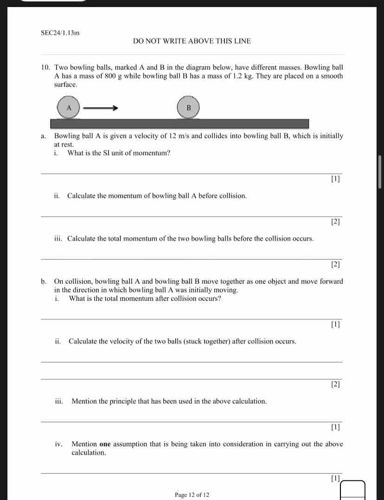Two bowling balls, marked A and B in the diagram below, have different masses. Bowling ball A has a mass of 500 g while bowling ball B has a mass of 1.2 kg. They are placed on a smooth surface. a. Bowling ball A is given a velocity of 12 m/s and collides into bowling ball B, which is initially at rest. i. Calculate the momentum of bowling ball A before collision. ii. Calculate the total momentum of the two bowling balls before the collision occurs. b. On collision, bowling ball A and bowling ball B move together as one object and move forward in the same direction. i. What is the momentum after collisions occur? ii. Calculate the velocity of the two balls (stuck together) after collision occurs. iii. Mention the principle that has been used in the above calculation. iv. Mention one assumption that is being taken into consideration in carrying out the above calculation.

Answer
To solve the problem, we need to work through each part step by step. **a.i. Calculate the momentum of bowling ball A before collision.** Momentum (p) is calculated using the formula: \[ p = m \cdot v \] Where: - m = mass of the object (in kg) - v = velocity of the object (in m/s) For bowling ball A: - Mass (m) = 500 g = 0.5 kg - Velocity (v) = 12 m/s Now, substituting in values: \[ p_A = 0.5 \text{ kg} \cdot 12 \text{ m/s} = 6 \text{ kg m/s} \] **a.ii. Calculate the total momentum of both bowling balls before the collision.** Since bowling ball B is at rest, its initial momentum is zero. Therefore, the total momentum before the collision is: \[ p_{total} = p_A + p_B = 6 \text{ kg m/s} + 0 = 6 \text{ kg m/s} \] **b.i. What is the momentum after collisions occur?** Since momentum is conserved in collisions, the total momentum after the collision will be equal to the total momentum before the collision: \[ p_{after} = p_{total} = 6 \text{ kg m/s} \] **b.ii. Calculate the velocity of the two balls (stuck together) after collision occurs.** After the collision, both balls move together, so we can calculate their combined mass and use momentum to find the velocity. - Combined mass = mass of A + mass of B = 0.5 kg + 1.2 kg = 1.7 kg From momentum conservation: \[ p_{after} = m_{combined} \cdot v_{after} \] \[ 6 \text{ kg m/s} = 1.7 \text{ kg} \cdot v_{after} \] Solving for \( v_{after} \): \[ v_{after} = \frac{6 \text{ kg m/s}}{1.7 \text{ kg}} \approx 3.53 \text{ m/s} \] **b.iii. Mention the principle that has been used in the above calculation.** The principle used is the **law of conservation of momentum**, which states that in a closed system, the total momentum before an event (collision, explosion, etc.) is equal to the total momentum after the event. **b.iv. Mention one assumption that is being taken into consideration in carrying out the above calculation.** One assumption is that there is no external force acting on the system. This means we assume the surface is smooth (frictionless) and other forces (like air resistance) are negligible.